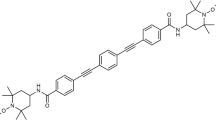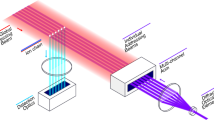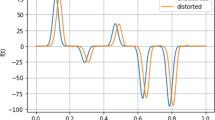Abstract
Quantum information processing offers potentially great advantages over classical information processing, both for efficient algorithms1,2 and for secure communication3,4. Therefore, it is important to establish that scalable control of a large number of quantum bits (qubits) can be achieved in practice. There are a rapidly growing number of proposed device technologies5,6,7,8,9,10,11 for quantum information processing. Of these technologies, those exploiting nuclear magnetic resonance (NMR) have been the first to demonstrate non-trivial quantum algorithms with small numbers of qubits12,13,14,15,16. To compare different physical realizations of quantum information processors, it is necessary to establish benchmark experiments that are independent of the underlying physical system, and that demonstrate reliable and coherent control of a reasonable number of qubits. Here we report an experimental realization of an algorithmic benchmark using an NMR technique that involves coherent manipulation of seven qubits. Moreover, our experimental procedure can be used as a reliable and efficient method for creating a standard pseudopure state, the first step for implementing traditional quantum algorithms in liquid state NMR systems. The benchmark and the techniques can be adapted for use with other proposed quantum devices.
This is a preview of subscription content, access via your institution
Access options
Subscribe to this journal
Receive 51 print issues and online access
$199.00 per year
only $3.90 per issue
Buy this article
- Purchase on Springer Link
- Instant access to full article PDF
Prices may be subject to local taxes which are calculated during checkout



Similar content being viewed by others
References
Simon, D. R. On the power of quantum computation. SIAM J. Comput. 26, 1474–1483 (1997).
Shor, P. W. Polynomial-time algorithms for prime factorization and discrete logarithms on a quantum computer. SIAM J. Comput. 26, 1484–1509 (1997).
Wiesner, S. Conjugate coding. Sigact News 15, 78–88 (1983).
Bennett, C., Bessette, F., Brassard, G., Salvail, L. & Smolin, J. Experimental quantum cryptography. J. Cryptol. 5, 3–28 (1992).
Cirac, J. & Zoller, P. Quantum computations with cold trapped ions. Phys. Rev. Lett. 74, 4091–4094 (1995).
Loss, D. & DiVincenzo, D. P. Quantum computation with quantum dots. Phys. Rev. A 57, 120–126 (1997).
Bocko, M. F., Herr, A. M. & Feldman, M. J. Prospects for quantum coherent computation using superconducting electronics. IEEE Trans. Appl. Supercond. 7, 3638–3641 (1997).
Shnirman, A., Schön, G. & Hermon, Z. Quantum manipulations of small josephson junctions. Phys. Rev. Lett. 79, 2371–2374 (1997).
Cory, D. G., Fahmy, A. F. & Havel, T. F. Ensemble quantum computing by nmr-spectroscopy. Proc. Natl Acad. Sci. USA 94, 1634–1639 (1997).
Gershenfeld, N. A. & Chuang, I. L. Bulk spin resonance quantum computation. Science 275, 350–356 (1997).
Kane, B. E. A silicon-based nuclear spin quantum computer. Nature 393, 133–137 (1998).
Jones, J. A., Mosca, M. & Hansen, R. H. Implementation of a quantum search algorithm on a quantum computer. Nature 392, 344–346 (1998).
Chuang, I. L., Vandersypen, L. M. K., Zhou, X., Leung, D. W. & Lloyd, S. Experimental realization of a quantum algorithm. Nature 393, 143–146 (1998).
Cory, D. G. et al. Experimental quantum error correction. Phys. Rev. Lett. 81, 2152–2155 (1998).
Nielsen, M. A., Knill, E. & Laflamme, R. Complete quantum teleportation. Nature 396, 52–55 (1998).
Marx, R., Fahmy, A. F., Myers, J. M., Bermel, W. & Glaser, S. J. Realization of a 5-bit nmr quantum computer using a new molecular architecture. Preprint quant-ph/9905087 at 〈http://xxx.lanl.gov〉 (1999).
Sörensen, O. W., Eich, G. W., Levitt, M. H., Bodenhausen, G. & Ernst, R. R. Product operator-formalism for the description of nmr pulse experiments. Prog. Nucl. Magn. Reson. Spectrosc. 16 (1983).
Barenco, A. et al. Elementary gates for quantum computation. Phys. Rev. A 52, 3457–3467 (1995).
Freeman, R. Spin Choreography (Oxford Univ. Press, 1998).
Schumacher, B. Sending entanglement through noisy quantum channels. Phys. Rev. A 54, 2614–2628 (1996).
Shor, P. W. in Proc. Symp. Foundations of Computer Science 56–65 (IEEE, Los Alamitos, California, 1996).
Aharonov, D. & Ben-Or, M. in Proc. 29th Ann. ACM Symp. Theory of Computing 176–188 (Association for Computing Machinery, New York, 1996).
Kitaev, A. Y. Quantum computations: algorithms and error correction. Uspekhi Mat. Nauk. 52, 53–112 (1997).
Knill, E., Laflamme, R. & Zurek, W. H. Resilient quantum computation. Science 279, 342–345 (1998).
Dür, W., Briegel, H.-J., Cirac, J. I. & Zoller, P. Quantum repeaters for based on entanglement purification. Phys. Rev. A 59, 169–181 (1999).
Emsley, L. & Pines, A. in Proc. Int. School of Physics, Enrico Fermi Vol. CXXIII, 123–266 (North-Holland, Amsterdam, 1994).
Knill, E., Chuang, I. & Laflamme, R. Effective pure states for bulk quantum computation. Phys. Rev. A 57, 3348–3363 (1998).
Weitekamp, D. P., Garbow, J. R. & Pines, A. Determination of dipole coupling constants using heteronuclear multiple quantum nmr. J. Chem. Phys. 77, 2870–2883 (1982).
Maffei, P., Elbayed, K., Brondeau, J. & Canet, D. Slice selection in nmr imaging by use of the b1 gradient along the axial direction of a saddle-shaped coil. J. Magn. Reson. 95, 382–386 (1991).
Vandersypen, L. M. K., Yannoni, C. S., Sherwood, M. H. & Chuang, I. L. Realization of logically labeled effective pure states for bulk quantum computation. Phys. Rev. Lett. 83, 3085–3088 (1999).
Acknowledgements
We thank D. Cory, G. Fernandez, T. Havel, S. Lacelle, D. Lemaster, D. Meyer, C. Unkefer, A. M. Wang and W. H. Zurek for help and discussions.
Author information
Authors and Affiliations
Corresponding author
Rights and permissions
About this article
Cite this article
Knill, E., Laflamme, R., Martinez, R. et al. An algorithmic benchmark for quantum information processing. Nature 404, 368–370 (2000). https://doi.org/10.1038/35006012
Received:
Accepted:
Issue Date:
DOI: https://doi.org/10.1038/35006012
This article is cited by
-
Noisy intermediate-scale quantum computers
Frontiers of Physics (2023)
-
Experimental measurement of bipartite entanglement using parameterized quantum circuits
Science China Physics, Mechanics & Astronomy (2022)
-
Models in quantum computing: a systematic review
Quantum Information Processing (2021)
-
Implementation of XY entangling gates with a single calibrated pulse
Nature Electronics (2020)
-
One-step method for preparing the experimental pure state in nuclear magnetic resonance
Science China Physics, Mechanics & Astronomy (2020)
Comments
By submitting a comment you agree to abide by our Terms and Community Guidelines. If you find something abusive or that does not comply with our terms or guidelines please flag it as inappropriate.



